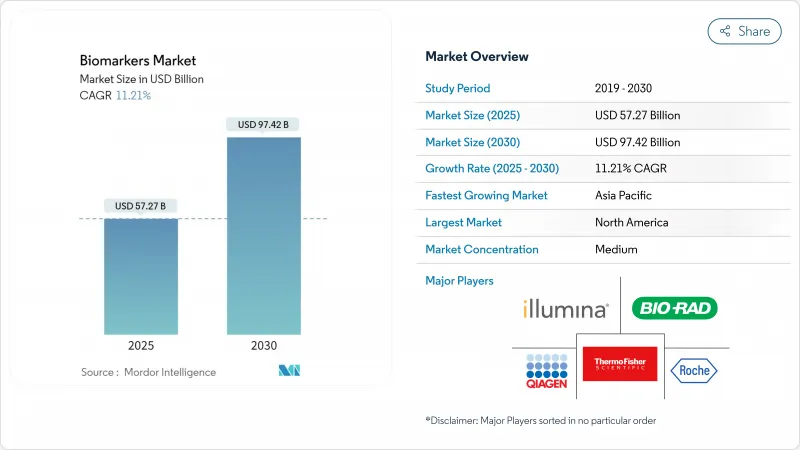
|
市場調査レポート
商品コード
1851804
バイオマーカー:市場シェア分析、産業動向、統計、成長予測(2025年~2030年)Biomarkers - Market Share Analysis, Industry Trends & Statistics, Growth Forecasts (2025 - 2030) |
||||||
カスタマイズ可能
適宜更新あり
|
|||||||
| バイオマーカー:市場シェア分析、産業動向、統計、成長予測(2025年~2030年) |
|
出版日: 2025年07月01日
発行: Mordor Intelligence
ページ情報: 英文 120 Pages
納期: 2~3営業日
|
概要
バイオマーカー市場は2025年に572億7,000万米ドル、2030年には974億2,000万米ドルに達すると予測され、CAGRは11.21%です。

この勢いは、人工知能を活用した探索パイプライン、規制当局によるデジタルエンドポイントの受け入れ拡大、腫瘍学、免疫学、神経学、循環器学にわたる精密医療の推進を反映しています。ブレイクスルーデバイスの継続的な指定、マルチオミクスツールキットの拡大、標的治療に報いる償還経路は、日常診療における有効な検査の取り込みを促進します。コンパニオン診断薬は、特にがん領域において、早期発見と治療法適合へのアクセスを拡大するリキッドバイオプシーとDNAメチル化アッセイにおいて、治療方針の決定を支えるものとなっています。プロテオミクス・プラットフォーム、クラウド・バイオインフォマティクス、リアルワールド・エビデンス・ソリューションへの投資により、ベンダーは消耗品、サービス、ソフトウェアから経常収益を得ることができます。しかし、複雑な保険償還政策とデータプライバシー規制が、短期的な導入曲線を抑制しています。
世界のバイオマーカー市場の動向と洞察
生命を脅かす疾患の有病率の上昇
慢性疾患や生命を脅かす疾患は、洗練されたバイオマーカーパネルの需要を加速させています。関節リウマチは米国で毎年20万人の新規患者を記録しており、早期発見のために感度74%、特異度90%に達する14-3-3ηタンパク質アッセイの採用に拍車をかけています。アルツハイマー病では、血液ベースのpTau217が最近FDAのブレークスルー指定を獲得し、脳脊髄液検査よりも利用しやすくなりました。ヘルスケアシステムは予防医学に重点を置いており、腫瘍学、心臓病学、神経変性にまたがるマーカーを一度に測定できるマルチプレックス・プラットフォームが求められています。このような幅の広さが、バイオマーカー市場を堅調な成長軌道に乗せています。
早期かつ正確な診断への需要の高まり
早期介入戦略により、バイオマーカーは確認ツールではなく、極めて重要な予測機器となっています。マンモグラフィから5年間の乳がんリスクを予測するAIモデルCLAIRITY BREASTは、画像診断バイオマーカーがいかに予防的スクリーニングをサポートしているかを示しています。循環腫瘍DNAメチル化を検出するリキッドバイオプシーアッセイが、24時間のワークフローで肝細胞がんの96.67%の感度を達成。ウェアラブルは、心代謝指標を継続的にモニタリングし、医師によるタイムリーな警告を発することで、診療所以外での検出を拡大します。拡張知能を利用した分析により、解釈時間が短縮され、様々な医療現場への統合が容易になり、バイオマーカー市場が拡大します。
複雑な償還と規制経路
世界的に異なるルールが商業化を遅らせています。FDAは、臨床検査室が開発した検査の実施裁量を4年かけて段階的に縮小し、臨床検査室に機器レベルの規制を課します。欧州の体外診断薬規制はエビデンスの要求を厳しくしたが、アジア太平洋の要件は一貫していないです。支払者は実臨床でのエビデンスを余分に要求することが多く、イノベーターの収益を遅らせ、バイオマーカー市場の拡大をわずかに阻害しています。
セグメント分析
がん領域はバイオマーカー市場の2024年の売上高の46.52%を占めました。遺伝子マーカーとタンパク質マーカーへの数十年にわたる投資と迅速なコンパニオン診断薬承認がリーダーシップを維持しています。エピジェネティックなリキッドバイオプシー検査は、10mlの採血から複数の腫瘍型を同定できるようになり、早期治療へのアクセスを向上させています。
免疫疾患は2030年に向けてCAGR 11.98%で進展し、その差を縮めています。自己免疫疾患の有病率の上昇と、血清反応陰性関節リウマチにおける14-3-3η蛋白のようなマーカーの検証により、新たな臨床ワークフローが開かれます。サイトカインストームと治療反応を追跡できるより広範なマルチプレックスパネルが、このバイオマーカー市場の長期的成長を後押しします。
有効性のバイオマーカーは、2024年の支出額の58.23%を占め、進行予測、治療選択の指針、代替エンドポイントとしての使用を反映しています。腫瘍学と循環器学の臨床試験は、タイムラインの短縮と投与量の最適化のために確立されたマーカーに依存しています。
安全性バイオマーカーCAGR 11.81%で急上昇、規制当局が上市承認前にヒトに関連する毒性指標を求めるためAIを活用したin-vitroモデルでは、腎や肝のストレスシグナルが数時間以内に読み取られ、より早い投与中止の判断が可能となります。これらのパネルの拡大はリスク軽減戦略を支え、ファーマコビジランスのバイオマーカー市場規模を拡大します。
地域分析
北米は2024年に世界売上高の42.88%を占めたが、これはバイオマーカーを規制当局への提出に適格とし、支払者負担を合理化するFDAプログラムによるものです。強固な償還制度と広範な病院ネットワークにより、高い検査件数が維持されています。産学コンソーシアムによるベンチサイドからベッドサイドへの迅速な移行が、バイオマーカー市場における地域的影響力を強化しています。
アジア太平洋地域の2030年までのCAGRは11.89%です。中国の24項目に及ぶ規制改革は革新的デバイスの認可を早め、日本の国家バイオテクノロジー計画は10年後までに15兆円の市場規模を目標としています。人口動態の高齢化とリキッドバイオプシーに対する新たな償還コードが急速な普及に拍車をかけ、アジア太平洋地域はバイオマーカー市場の主要な需要拠点となります。
欧州は体外診断薬規制の厳しいエビデンス要求のもとで一貫した成長を維持します。国境を越えた調査ネットワークにより、慢性疾患管理のためのデジタルおよびマルチオミクスバイオマーカーを検証する大規模コホートが生み出されています。中東・アフリカ、南米は、医療システムの近代化と医療ツーリズムが、新興のバイオマーカー市場エコシステムの中で先端診断薬への需要を刺激するため、グリーンフィールドの機会を提供します。
その他の特典:
- エクセル形式の市場予測(ME)シート
- 3ヶ月間のアナリストサポート
よくあるご質問
目次
第1章 イントロダクション
- 調査の前提条件と市場の定義
- 調査範囲
第2章 調査手法
第3章 エグゼクティブサマリー
第4章 市場情勢
- 市場概要
- 市場促進要因
- 生命を脅かす疾患の増加
- 早期かつ正確な診断に対する需要の高まり
- マルチオミクス技術の進歩
- がん領域におけるコンパニオン診断薬の拡大
- AIを活用したマルチモーダルバイオマーカー探索
- デジタルバイオマーカーの普及
- 市場抑制要因
- 複雑な償還と規制の経路
- 高いアッセイ開発・検証コスト
- 現実のデジタルバイオマーカー社会におけるデータ・プライバシーの課題
- 低資源ラボにおけるサンプルから回答までのワークフローのばらつき
- 規制情勢
- テクノロジーの展望
- ポーターのファイブフォース分析
- 供給企業の交渉力
- 買い手の交渉力
- 新規参入業者の脅威
- 代替品の脅威
- 競争企業間の敵対関係
第5章 市場規模と成長予測
- 疾患別
- がん
- 心血管疾患
- 神経疾患
- 免疫疾患
- 腎障害
- その他の疾患
- タイプ別
- 効果バイオマーカー
- 予後バイオマーカー
- 予測バイオマーカー
- 薬力学バイオマーカー
- 代替エンドポイントマーカー
- 安全性バイオマーカー
- バリデーションバイオマーカー
- 効果バイオマーカー
- 機構別
- ジェネティックバイオマーカー
- エピジェネティックバイオマーカー
- プロテオミクスバイオマーカー
- リピドミクスバイオマーカー
- その他
- 用途別
- 臨床診断
- 創薬と医薬品開発
- 個別化医療
- 疾病リスク評価
- その他
- 製品別
- 消耗品
- 機器
- サービスおよびソフトウェア
- 地域別
- 北米
- 米国
- カナダ
- メキシコ
- 欧州
- ドイツ
- 英国
- フランス
- イタリア
- スペイン
- その他欧州地域
- アジア太平洋地域
- 中国
- 日本
- インド
- オーストラリア
- 韓国
- その他アジア太平洋地域
- 中東・アフリカ
- GCC
- 南アフリカ
- その他中東・アフリカ地域
- 南米
- ブラジル
- アルゼンチン
- その他南米
- 北米
第6章 競合情勢
- 市場集中度
- 市場シェア分析
- 企業プロファイル
- Abbott Laboratories
- F. Hoffmann-La Roche Ltd
- Thermo Fisher Scientific Inc.
- Qiagen N.V.
- Danaher Corp.(Beckman Coulter)
- Siemens Healthineers AG
- Bio-Rad Laboratories Inc.
- Agilent Technologies Inc.
- Illumina Inc.
- PerkinElmer Inc.
- Merck KGaA
- Becton Dickinson & Co.
- Hologic Inc.
- Sysmex Corp.
- Myriad Genetics Inc.
- Epigenomics AG
- Quanterix Corp.
- GE Healthcare
- BioMerieux SA
- Atlas Genetics Ltd

